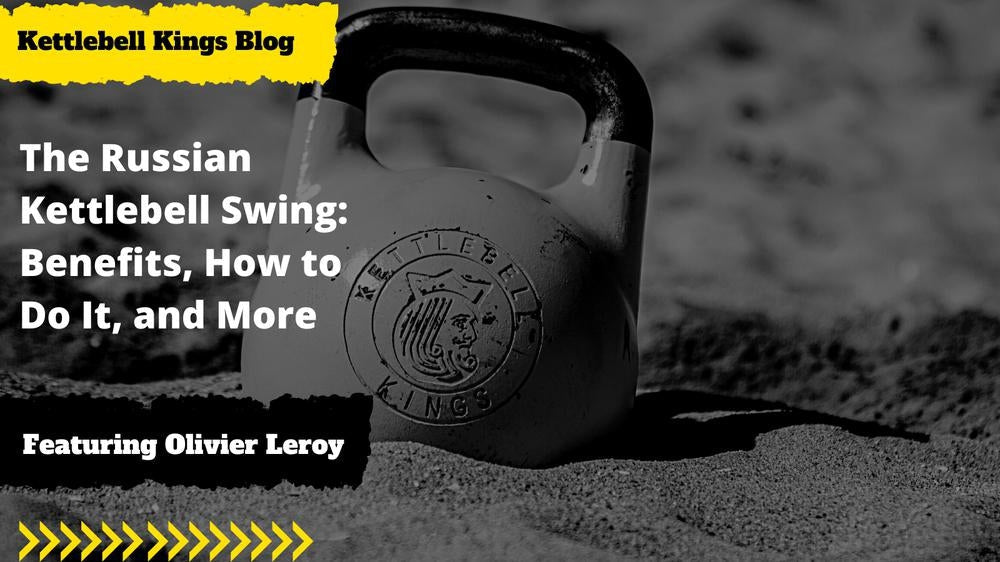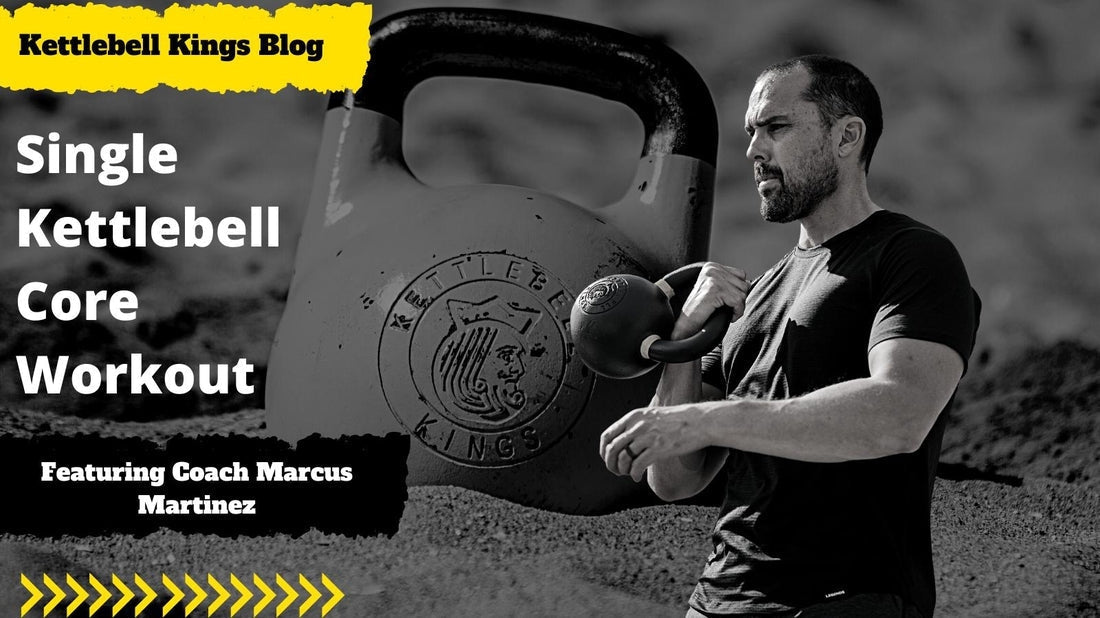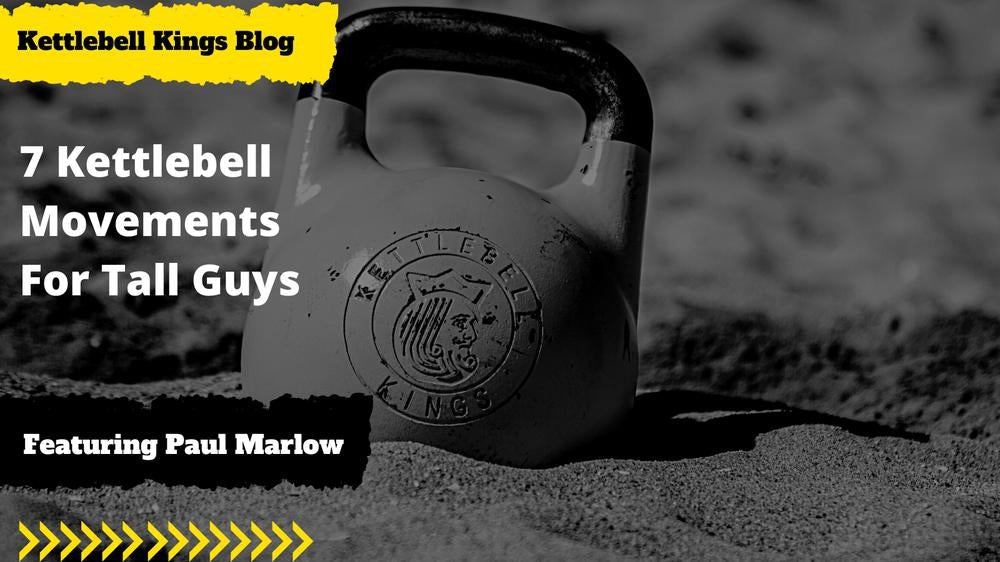The kettlebell swing is one of the best ballistic strength training exercises on the planet. (Yes, I said it!)
It combines a squat with a swinging motion to engage most of the muscle groups in your body: your entire posterior chain from shoulders to calves, your quads, core, even your shoulder and forearm muscles.
It’s not just great for overall fitness; it’s a staple of functional conditioning and a CrossFit classic!
But it turns out that one slight variation of form can change the nature of the workout significantly.
In this article, we will look at the most popular form of the kettlebell swing, the Russian kettlebell swing, compare it to the American swing, and drop some serious technique tips so that you can do it like a boss.
Let’s get to swingin’!
American vs. Russian KB Swings
A lot of people don’t realize that there are, in fact, two different types of kettlebell swings:
Russian kettlebell swing – This is the exercise that started it all, the “OG” as it were. The Russian kettlebell swing involves the classic squatting motion and a swing that brings the kettlebell swinging up to chest height. For this exercise, the hips do a lot of the work, thrusting forward to facilitate the swing.American kettlebell swing – When the exercise became popular in the West, it got altered slightly in order to change the focus of the movement. With the American KB swing, the weight is swung all the way overhead, to full extension of the arms. This leads to a greater range of motion that demands greater force generation to make the full swing. More work gets done with every rep.
Benefits of Russian Kettlebell Swings
There are a lot of proponents for the American kettlebell swing (hence its popularity in the West), but I’d argue that the Russian kettlebell swing is the best kettlebell swing, offering a few benefits that American KB swings don’t.
Benefit #1: More Focused
Let’s take a look at the muscles worked in kettlebell swings, both the American and Russian versions.
The main muscles doing the work are:
- Hamstrings
- Glutes
- Spinal erectors
- Upper back muscles
However, throughout the range of motion, other muscles are also brought into play, including:
- Quads (for the squat)
- Shoulders (for the swing and raise)
- Arm muscles (for the swing/raise and to maintain a proper grip on the kettlebell)
- Abs (to maintain stability through the swing)
Really, the only muscle group that doesn’t get activated is the chest!
With the American kettlebell swing, the full range of motion to swing overhead increases the engagement of the shoulders, arms, and abs.
This is why the American variation is believed to be more demanding and leads to fatigue faster—sometimes believed to be a good thing, but not always. Faster fatigue means you’re less likely to maintain proper form throughout the full set, and there is less focus on the critical posterior chain muscles.
The Russian KB swing, on the other hand, involves a shorter range of motion, which means that the focus remains largely on the prime movers engaged in the exercise. There is less shoulder and arm muscle activation, which means the upper back, core, and legs do the majority of the work. There is also more energy available for those muscles, so you don’t hit fatigue as quickly.
The focus is on the hip-thrusting movement that facilitates the swing, and the contraction of all the primary muscles necessary to keep your motion controlled. No strength is “wasted” trying to lift the weight over your head. It’s all about that swing, baby!
Benefit #2: Less Risk of Injury
Let’s be honest: the kettlebell swing isn’t the safest exercise. In addition to ballistic movement, it moves your shoulder joints through multiple planes of motion and increases the strain on your spinal erector muscles. As you’ll see below, there are a lot of mistakes that could cause injuries as you perform the KB swing.
And this is another reason the Russian KB swing is the safer choice.
Because you’re working in a smaller range of motion, there is less likelihood of injury. All of your muscular energy goes toward the smaller, more controlled movement, so you won’t run out of steam as quickly (which always leads to poor form).
Plus, the lack of overhead swing also means your shoulder joints aren’t at risk. It takes a lot of strength to lift the kettlebell overhead, and moving through multiple planes of motion can create instabilities that lead to joint injuries. The chest-level swing of the Russian KB swing is exponentially safer for your shoulders and lower back both.
How to Do the Russian Kettlebell Swing Like a Pro
Time to see how the sausage is made and get into the nitty-gritty details of how to perform the Russian kettlebell swing right!
Really, all you’ll need for this exercise is a pair of competition kettlebells and a bit of space, and you’re good to go. No other equipment needed—which is why it’s such a popular addition to your home workouts.
To perform the Russian kettlebell swing:
- Stand with your feet planted wider than shoulder width apart, toes pointed straight ahead (or slightly outward to engage the hip muscles).
- Place the kettlebell between your feet, directly below you. Bend at the knees to lower into a squat and grip the kettlebell.
- Lift the weight off the ground and swing it slightly backward. Inhale, keep your shoulder blades down, your neck relaxed, and head up throughout this movement.
- Exhale forcefully and contract your glute muscles to thrust your hips forward and begin the swing.
- Bring the kettlebell up in front of you, straightening your legs to stand upright. DO NOT lock out your knees, and keep your elbows soft throughout the movement.
- Maintain a straight spine and avoid rounding in the back as you lift the kettlebell to the level of your chest, and again when lowering the weight once more.
- Allow the kettlebell to swing between your legs and behind you. Try to keep the weight as close to your groin as safely possible—lowering too far toward the floor can lead to rounding in your back.
- Repeat as desired.
Common Mistakes in the Russian Kettlebell Swing
As I mentioned above, the kettlebell swing is far from the safest exercises you can do. The ballistic movement can increase the strain on your joints, and there are plenty of opportunities throughout the motion for fatigue or instability to compromise your form.
Keeping that form tight is ABSOLUTELY crucial for the success of any kettlebell swing, but especially the Russian KB swing. Here are some of the most common mistakes you can be on the lookout for and take active efforts to avoid:
Mistake #1: Rounding Your Back- If, at any time, your back starts to round, you’re putting your spinal muscles at risk. You have to keep a straight spine throughout, as that engages the musculature all the way from your upper back (lats and traps) through your lower back and down your glutes and hamstrings.
- Proper spinal alignment ensures the entire posterior chain does the work. Rounding your back reduces engagement of the muscles above and below your trunk, placing all the strain on your lower back and leading to a greater risk of injury.
Mistake #2: Lifting With Your Shoulders/Arms
- There will always be the temptation to use your shoulders and arms to facilitate the swing. While they do engage through the movement, you want to make sure the focus is on your hips and glutes in that initial thrusting movement.
- It’s only when your hips don’t have sufficient power to complete that thrust that your arms and shoulders have to work.
- This is one area where the Russian kettlebell swing proves superior to its American counterpart. Because you’re only bringing the weight up to chest level, it’s far easier to focus on removing the shoulders and arms from the equation as much as possible to keep the focus on your hips and glutes.
Mistake #3: Swinging Too Low
- When you let the kettlebell swing too low, it increases rounding of your back and places greater strain on your spine. You may be swinging too low because the weight is too heavy for you to safely lift with your hips and glutes, or it could be the result of incorrect form.
- Whatever the case, focus on keeping the weight as close to your groin level as possible. Finish the back swing earlier with your wrists at leg level rather than your elbows. Cutting the depth of the swing will shift the focus back to the thrusting-standing motion powered by your hips and glutes.
Mistake #4: Wobbling/Tipping
- Your balance shouldn’t be compromised by the swinging motion because your body naturally adapts to compensate for the weight. If you’re wobbling or tipping, it means you’re likely using incorrect form.
Mistake #5: Muted Hip Movement
- Again, keep in mind that this exercise is ALL ABOUT THE HIPS AND GLUTES! That initial hip thrust is what gets the weight swinging upward, and that final hip thrust at the end of the movement holds the weight at chest level and maximizes glute engagement.
- Pay close attention to your hips and make sure they’re moving fully through the entire range of motion. If your hips are “muted” or not moving, you need to work on your form.
The Bottom Line
The Russian kettlebell swing has the potential to be a truly excellent addition to your workout routine!
It’s guaranteed to build explosive strength and core power, and thanks to the smaller range of motion, is less likely to lead to injuries than the American kettlebell swing.
Use the advice above to help you master the form and eradicate these common mistakes from your workout, and you’ll be swinging those kettlebells like a BEAST in no time.










